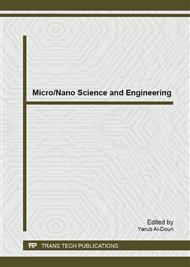p.67
p.72
p.77
p.82
p.84
p.88
p.92
p.96
p.101
Reactive Ion Etching Parameter Effect on Aluminum Bond Pad Surface Morphology
Abstract:
Reactive Ion Etching (RIE) is an important process in fabrication of semiconductor devices. Design Of Experiment (DOE) has been used to study the effect of Reactive Ion Etch (RIE) towards surface morphology of aluminum bond pad. Important RIE factors involved in this experimental study are ratio of Tetrafluoromethane (CF4), Argon gas flow, BIAS, and ICP power. Different combinations of these factors produces different results of surface morphologies which was obtained using Atomic Force Microscopic (AFM). Produced results shows that overall surface roughness of the pad is affected by RIE and DOE offers a better way to optimize the desired outcome.
Info:
Periodical:
Pages:
84-87
Citation:
Online since:
April 2014
Keywords:
Price:
Сopyright:
© 2014 Trans Tech Publications Ltd. All Rights Reserved
Share:
Citation:


